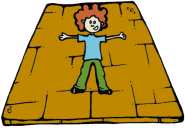|
R-2000 Housing:Building a Healthy House
 Materials and features you decide to use in your home will affect the indoor air quality, as well as the energy efficiency within your home. In this section, we will go into further detail about specific components of your home, and the proper methods of use and installation. Materials and features you decide to use in your home will affect the indoor air quality, as well as the energy efficiency within your home. In this section, we will go into further detail about specific components of your home, and the proper methods of use and installation.
Fireplaces
Everyone enjoys sitting in front of a warm fireplace on a cold winter's night. Unfortunately though, fireplaces are a source of respirable particles, carbon monoxide, and nitrogen dioxide. Although less common, it is actually advantageous to have a fireplace on an interior wall as opposed to an exterior wall. This is because the chimney must be warm in order for the smoke to be drawn up and out of the house. If the chimney is on an exterior wall, it will likely be cold when the fire is first lit, and the smoke and other gases won't exit the house
The Garage
 Especially in colder areas of the country, attached garages are very popular. Although very convenient, they can be one of the greatest sources of air pollution within the home. Garages contain exhaust gases from vehicles, and they also often contain pesticides, fertilizers, paints, solvents, and other sources of pollution. An unattached garage is the best defense from these gases entering the home. However, if the attached garage is made with a vapour-retardant in the walls, it can be fairly safe. Especially in colder areas of the country, attached garages are very popular. Although very convenient, they can be one of the greatest sources of air pollution within the home. Garages contain exhaust gases from vehicles, and they also often contain pesticides, fertilizers, paints, solvents, and other sources of pollution. An unattached garage is the best defense from these gases entering the home. However, if the attached garage is made with a vapour-retardant in the walls, it can be fairly safe.
The Bathroom
The biggest problem in the bathroom is the accumulation of moisture, which can lead to biological contaminants like molds, fungi, and bacteria.
 The best defense is to have a good mechanical ventilation system that vents to the outside of the house. In some homes, the fan vents to the attic -- which only moves the moisture problem out of your bathroom and into your attic!
The best defense is to have a good mechanical ventilation system that vents to the outside of the house. In some homes, the fan vents to the attic -- which only moves the moisture problem out of your bathroom and into your attic!
Gas Appliances
Some people prefer to cook with gas stoves and ovens. If your home has gas appliances, you need to make sure there is adequate ventilation in the room they're located in. There should be a range hood with exhaust fan above the stove, and it should be vented outdoors!
Site Selection
 The lot your house is built on can have many important impacts on your home. There are several things you should consider about the lot you're looking at. First, you should make sure the lot isn't near any potential pollution sources. You should avoid areas that are close to industry or congested urban areas. You should also avoid areas with poor soil drainage, or a high radon content in the ground. The vegetation surrounding your lot is also an important thing to consider. Trees can block cold winter winds, while providing shade during the hot summer months. On the other hand, trees that are located too close to the house can give surface water a route to the basement via their roots. The lot your house is built on can have many important impacts on your home. There are several things you should consider about the lot you're looking at. First, you should make sure the lot isn't near any potential pollution sources. You should avoid areas that are close to industry or congested urban areas. You should also avoid areas with poor soil drainage, or a high radon content in the ground. The vegetation surrounding your lot is also an important thing to consider. Trees can block cold winter winds, while providing shade during the hot summer months. On the other hand, trees that are located too close to the house can give surface water a route to the basement via their roots.
Daylighting
Ideally, your house should capitalize on the daylight that shines on it every day. Proper positioning of windows can dramatically increase the warmth in south-facing rooms during the winter.
 At the same time, north-facing rooms should have smaller windows to minimize the heat that escapes to the cold winds. During the summer, proper landscaping can provide a great deal of shade for the house. Trees can let light strike your house during the winter, but can block the sun during the summer due to their leaf cycle.
At the same time, north-facing rooms should have smaller windows to minimize the heat that escapes to the cold winds. During the summer, proper landscaping can provide a great deal of shade for the house. Trees can let light strike your house during the winter, but can block the sun during the summer due to their leaf cycle.
Windows
Windows are a very important feature in every home. They allow natural light to enter, as well as outside air. However, they are traditionally a source of heat loss. Modern windows are double-paned, with an inert gas in between. The gas in between the panes discourages heat from escaping through the window. As mentioned above, the size and placement of your windows can have an important effect on the energy efficiency of your house.
Paint

If painting is done in your house, you should choose a paint with very few volatile organic compounds (VOCs). All paints release some amount of VOCs after the painting is completed. Sometimes, these chemicals can be released for as long as several months after the paint has been applied! These chemicals can cause nausea, headaches, respiratory irritation and skin irritation. If you're planning on painting indoors, consider doing it during the warmer months, when windows can be opened to help ventilate the area.
Paint strippers and thinners
 Paint strippers and thinners are notorious for their high levels of VOCs. They can cause illness or even death if inhaled for extended periods of time. If you must use these products, use them in well-ventilated areas. It is often best to leave the house for several hours after these products have been used, to allow the area to "air out".
Paint strippers and thinners are notorious for their high levels of VOCs. They can cause illness or even death if inhaled for extended periods of time. If you must use these products, use them in well-ventilated areas. It is often best to leave the house for several hours after these products have been used, to allow the area to "air out".
Stains and Varnishes
Often, these products contain high levels of VOCs that are released as you use them. Even after drying, high humidity can cause them to release more gases. You should look for a product with few VOCs.
Wallpaper
It is possible to buy wall paper treated with fungicides to prevent the growth of molds. Like everything else, you should choose an adhesive that contain few chemicals that are capable of off-gassing.
Flooring
 Most flooring is quite safe, although you should try to use adhesives with very few VOCs. Carpets are nice, but they often accumulate a lot of dust and biological pollutants. For this reason, you should try to stick to flat, easy to clean flooring in your house. If you want carpeting, try to keep it to a minimum.
Most flooring is quite safe, although you should try to use adhesives with very few VOCs. Carpets are nice, but they often accumulate a lot of dust and biological pollutants. For this reason, you should try to stick to flat, easy to clean flooring in your house. If you want carpeting, try to keep it to a minimum.
Cabinetry
The wood used for cabinets should have been treated with a low VOC sealer. You should try to avoid particle board, because it may contain formaldehyde and other VOCs.
Lighting
As discussed above, the ideal house would take advantage of natural light as much as possible.  Of course, the sun cannot provide all of our lighting needs. There are many choices in lighting these days. Incandescent lights (old-style bulbs) are common because they're inexpensive. However, they have a relatively short life and they are less energy efficient. Some 90% of the energy that incandescent lights use goes into the generation of heat, and not light at all! Compact fluorescent lights can be used for increased energy efficiency: they last up to 10 times as long as normal light bulbs and use 75% less energy. Of course, the sun cannot provide all of our lighting needs. There are many choices in lighting these days. Incandescent lights (old-style bulbs) are common because they're inexpensive. However, they have a relatively short life and they are less energy efficient. Some 90% of the energy that incandescent lights use goes into the generation of heat, and not light at all! Compact fluorescent lights can be used for increased energy efficiency: they last up to 10 times as long as normal light bulbs and use 75% less energy.
Halogen lamps have become popular recently because of the excellent colour and quality of light they produce. They are more energy efficient than incandescent lights, and have a longer life. One drawback is that halogen lamps produce a great amount of heat, and care must be taken to prevent fires from occurring.
House Pressure
Air pressure is the force of air entering or leaving your home. It is affected by several factors including the outside weather, appliances used indoors, and mechanical ventilation systems. There are three categories that your house pressure can fall into:
Positive Pressure occurs when too much air is being brought into the house. This can cause the conditioned air (that has been heated or cooled) to be pushed through windows, door, vents, and other outlets.
Negative Pressure occurs when air is leaving the home, but it is not being replaced by fresh air. This can be a serious problem, because a vacuum can occur, and exhaust gases won't leave the house properly. Whenever air leaves a building, there must be new air to replace it.
Neutral Pressure is when the pressure inside the house is about equal to the outside pressure. This is ideal, because the amount of air leaving the home is the same amount that is entering the home.
Ideally, your home should have a mechanical ventilation system that keeps your house in neutral pressure.
Heat Recovery Ventilator
In an effort to conserve energy while maintaining adequate ventilation within the home, the heat recovery ventilator (HRV) was developed. The HRV is an important part of R-2000 homes, because it provides continuous clean air into the home -- a great advantage for people with asthma or allergies. The HRV not only brings in fresh air and gets rid of stale air, but it also conserves the heat within the home during the process. As warm air leaves the home, it heats the cool air entering the home. This means less energy needs to be used to mechanically heat the incoming air, and less heat is lost from warm air leaving the house.
|



This digital collection was produced under contract to Canada's Digital Collections program, Industry Canada. The web site was produced by a youth team at the Saskatchewan Lung Association.
